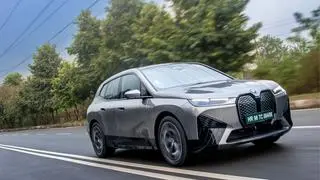It is bound to be a long argument if we delve on the subject of the pros and cons of the sub-four-metre sedan. Sceptics have been saying that the compact sedan is a worthless sub-segment, which is unlikely to lead to any competitive advantage for India in the long term given the fact that the category doesn’t exist anywhere else in the world.
But apparently buyers still want to choose from cars in this segment and there is still so much interest that car-makers are shoring up their prospects with facelifts and new generation models of their compact sedans.
With the debut of the new Maruti Suzuki Dzire just weeks away, Hyundai tried to outrace them with the official launch of the new 2017 Xcent. Built from the Grand i10, the Xcent is still pretty fresh, but Hyundai has gone ahead and done a facelift on both the hatch and the sedan versions. But, unlike the minor model modification that the Grand i10 received, the Xcent gets a bit more of new kit and a new diesel heart too.
DesignExternally, the new Xcent is very similar in its design. But, the one target that the redesign has managed to partly achieve is to make the compact sedan less gawky that it was before. The rear of the car is where the changes have made an impact even more, making it look less like a hatchback with a slapped on boot. The new combination tail-lamps with a very European flavour have contributed much to make it seem more like a sedan. The changes to the front have focused on making the Xcent present an aggressive profile. The bonnet grille and the front fender are completely new with new chrome slats, garnishes and LED daytime running lights. The bonnet panel is still very sharply sloped and so, despite the large headlamps, the front of the Xcent still looks more suitable for a hatch. But, to emphasise width, the front fender of the car now gets an air curtain feature which improves the car’s aerodynamics and it runs across the lower part of the bumper. The new 2017 model also gets a dual-tone rear fender with a matching feature to visually enhance the sense of width. The other addition are the new two-tone 15-inch alloy wheels.
CabinStepping into the cabin of the new Xcent also gives you a sense of déjà vu. The dashboard is very familiar because it is pretty much the same in terms of design. But the addition of a few new features boosts the appeal of this model. The most significant of these is the new seven-inch touchscreen infotainment system with smartphone navigation, and mirror link with a choice between Android Auto and Apple CarPlay. The steering wheel is the same unit, but has elegantly arranged controls for taking calls and other infotainment activations. The instrument cluster gets a blue and white illumination combo.
The seats are comfy and the upholstery is helpfully firm. But there is no escaping the feeling of being inside a hatch-sized sedan’s cabin. You feel that at the rear seats even more where it is a squeeze to fit three adults. Similarly, there is no escaping the fact that there is a lot of plastic all around, including the door panels and floor console, but their fit and finish quality is very good. Rear centre armrest and the dedicated rear aircon vents will be very useful for back-benchers. The neatly fabricated gear shift stick is another highlight of the cabin.
The 2017 Xcent is offered with both petrol and a diesel engine. The petrol engine is a carry forward, but I test drove the new Xcent 1.2L U2 CRDi diesel variant.
PerformanceThis model gets a new, larger 1,186 cc diesel engine compared to the outgoing model’s 1.1-litre. The change in size of the engine may be small and the step up in power is also only about 3 bhp, but the character of the car on road feels like more than just an incremental change.
Peak power is now 75 PS and peak torque is just over 190 Nm. Peak torque is available from as low as 1,750 rpm. The previous engine felt a little slow on the uptake and naturally felt a bit underpowered even for a car this size. But, the new 1.2L U2 CRDi doesn’t seem weak or laboured at any point through the rev-band. Yes, it has a fairly narrow sweet spot with much of the torque and power being delivered within the 2,000-3,000 rpm, but you won’t need to wait for usable levels of engine response to kick in during the interval between idling (900 rpm) to start of peak torque at 1,750 rpm.
Unlike the ultra refined petrol engine, which you barely feel pulsing in the bonnet, the new diesel engine is still clearly an oil burner when you listen to the familiar rattle outside the car. Inside the cabin the noise has been very well contained, but mild vibrations do come through at the pedals and door panels.
BottomlineThe new Xcent gets an improvement in the suspension department too. Now, the car feels less jumpy and doesn’t thrash about over bad patches of road. So, should you buy one?
The Xcent diesel I test drove feels like an attractive update overall, even though individually the changes would seem less significant. It is still going to feel the heat from the new Maruti Suzuki Dzire, but at least the Hyundai compact sedan now has more positives batting for it. Prices for the new Xcent start from ₹5.38 lakh and range up to ₹8.41 lakh (ex-showroom, Delhi).








Comments
Comments have to be in English, and in full sentences. They cannot be abusive or personal. Please abide by our community guidelines for posting your comments.
We have migrated to a new commenting platform. If you are already a registered user of TheHindu Businessline and logged in, you may continue to engage with our articles. If you do not have an account please register and login to post comments. Users can access their older comments by logging into their accounts on Vuukle.